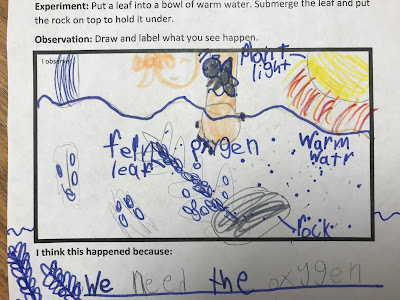What is photosynthesis?
How do plants "breathe"?
These were some of the questions of the week
for the first grade botanists.
We went to our classroom science laboratory to find some answers.
Our class lab complete with a plant light
We had read in a book that there are stomata (tiny holes) on the bottom of leaves.
We went outside and found a variety of leaves.
We looked up close with a microscope but couldn't really see holes.
So we tried submerging the leaves in warm water with our plant light shining on them.
And voila!
After a few hours, tiny bubbles began to appear
on the bottom of the leaves!
What could it be?
Air coming out of the stomata!
What kind of air? According to our book, oxygen!
We then filled out our lab reports.
Here are some of our "I think" portions of our lab report.
This is such an important part of the developmental stage of scientific thinking.
I think this happened because:
- When the plant was breathing, the water didn't let the air bubbles through so they stayed on it.
- We need the oxygen from the plants but only a little bit comes out at a time.
- [The plants] have been breathing through the holes and when they see the sun, they race up to it.
- [The plants] make the water, sun, and carbon dioxide into sugar and oxygen.
We then went on to talk more about photosynthesis
and how plants make their own food.
#bigideasforlittlepeople
#we💙science@seaburyschool
and how plants make their own food.
#bigideasforlittlepeople
#we💙science@seaburyschool















No comments:
Post a Comment